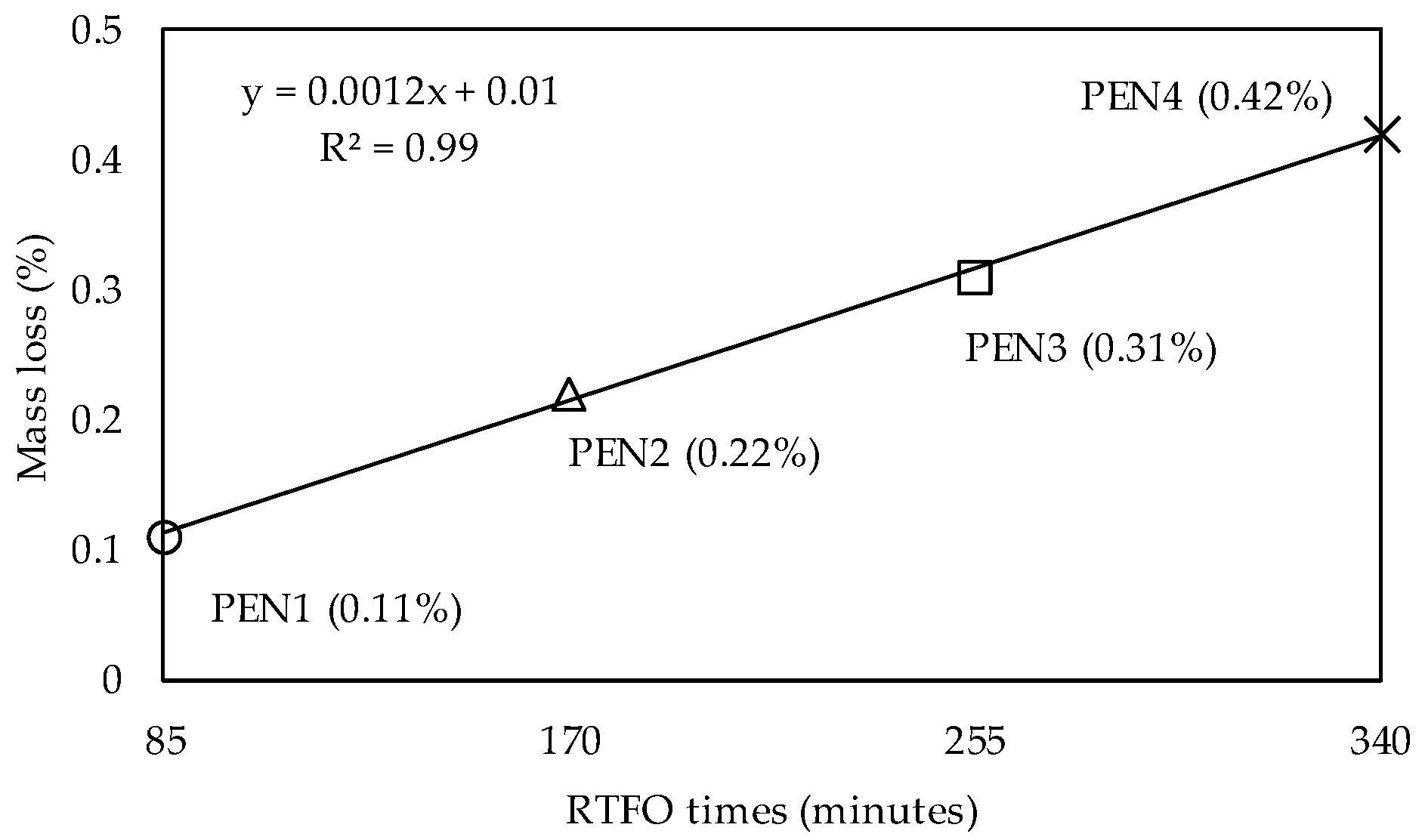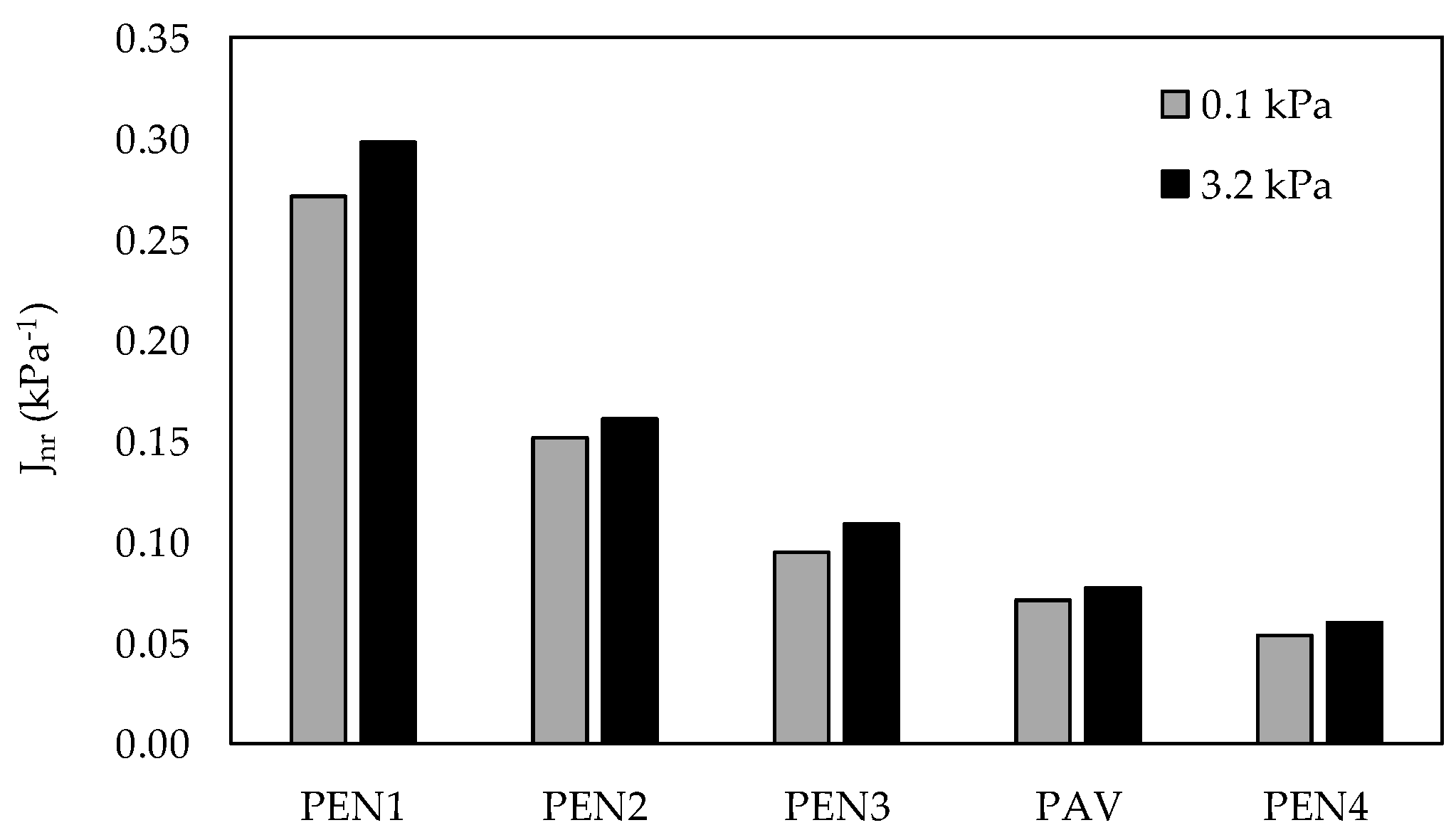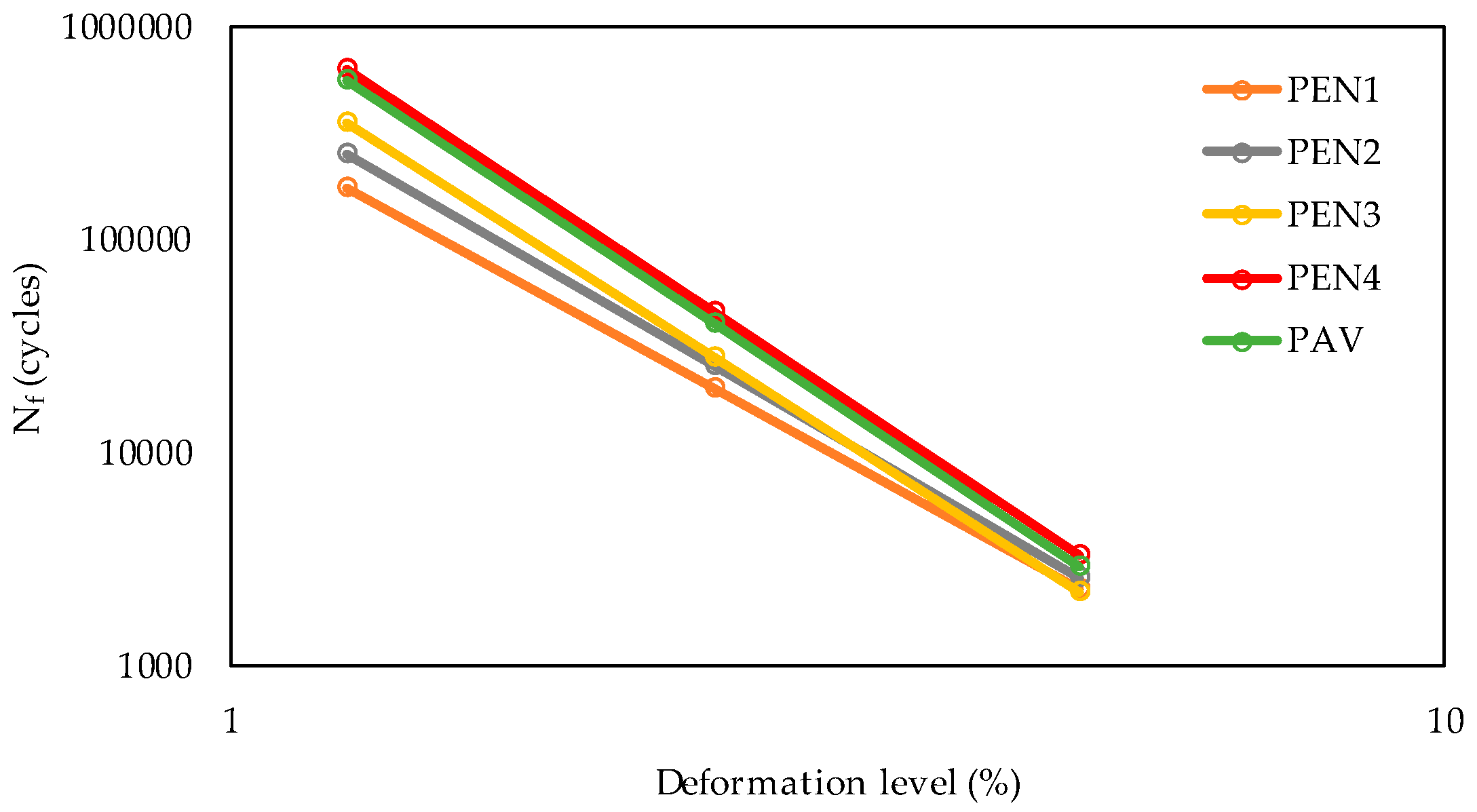Simulation of the Time Needed for Long-Term Asphalt Ageing in the Rolling Thin Film Oven Relative to That of the Pressure Ageing Vessel
Abstract
:1. Introduction
2. Materials and Methods
2.1. Materials
2.2. Methods
3. Results
3.1. Performance Grade (PG)
3.2. RTFO Mass Loss
3.3. SUPERPAVE Parameters G*/sinδ and G*.sinδ
3.4. MSCR Test Results
3.5. LAS Test Results
3.6. Estimation of the Equivalent Time
3.7. Equivalent Time Confirmation
4. Conclusions
Author Contributions
Funding
Institutional Review Board Statement
Informed Consent Statement
Data Availability Statement
Acknowledgments
Conflicts of Interest
References
- Tauste, R.; Moreno-Navarro, F.; Sol-Sánchez, M.; Rubio-Gámez, M.C. Understanding the bitumen ageing phenomenon: A review. Constr. Build. Mater. 2018, 192, 593–609. [Google Scholar] [CrossRef]
- Chowdhury, P.S.; Mullapudi, R.S.; Reddy, A. An investigation on the effect of aging on chemical and mechanical properties of asphalt binders. J. Mater. Civ. Eng. 2022, 34, 04022252. [Google Scholar] [CrossRef]
- Cui, B.; Wang, H. Oxidative aging mechanism of asphalt binder using experiment-derived average molecular model and ReaxFF molecular dynamics simulation. Fuel 2023, 345, 128192. [Google Scholar] [CrossRef]
- Wang, F.; Xiao, Y.; Cui, P.; Lin, J.; Li, M.; Chen, Z. Correlation of asphalt performance indicators and aging Degrees: A review. Constr. Build. Mater. 2020, 250, 118824. [Google Scholar] [CrossRef]
- Tian, Y.; Li, H.; Zhang, H.; Yang, B.; Zuo, X.; Wang, H. Comparative investigation on three laboratory testing methods for short-term aging of asphalt binder. Constr. Build. Mater. 2021, 266 Part B, 121204. [Google Scholar] [CrossRef]
- ASTM D2872; Standard Test Method for Effect of Heat and Air on a Moving Film of Asphalt (Rolling Thin-Film Oven Test). ASTM: West Conshohocken, PA, USA, 2004.
- ASTM D6521; Standard Practice for Accelerated Ageing of Asphalt Binder Using a Pressurized Ageing Vessel (PAV). ASTM: West Conshohocken, PA, USA, 2008.
- FHWA. The Universal Simple Aging Test. Federal Highway Administration Report FHWA-HRT-15-054, Washington, DC, USA. 2016. Available online: https://www.fhwa.dot.gov/publications/research/infrastructure/pavements/15054/index.cfm (accessed on 18 August 2023).
- Sirin, O.; Dalim, K.P.; Kassem, E. State of the art study on aging of asphalt mixtures and use of antioxidant additives. Adv. Civ. Eng. 2018, 2018, 3428961. [Google Scholar] [CrossRef]
- Mousavi, M.; Pahlavan, F.; Oldham, D.; Hosseinnezhad, S.; Fini, E.H. Multiscale investigation of oxidative aging in biomodified asphalt binder. J. Phys. Chem. 2016, 120, 17224–17233. [Google Scholar] [CrossRef]
- Hofko, B.; Handle, F.; Eberhardsteiner, L.; Hospodka, M.; Blab, R.; Fussl, J.; Grothe, H. Alternative approach toward the aging of asphalt binder. Transp. Res. Rec. 2019, 2505, 24–31. [Google Scholar] [CrossRef]
- Dhasmana, H.; Hossain, K.; Karakas, A.S. Effect of long-term ageing on the rheological properties of rejuvenated asphalt binder. Road Mater. Pavement Des. 2021, 22, 1268–1286. [Google Scholar] [CrossRef]
- Han, S.; Zhang, Z.; Zhang, Y.; Cheng, X.; Ren, W. Changes in rheological properties during asphalt aging. Pet 2019, 37, 1539–1547. [Google Scholar] [CrossRef]
- Guo, M.; Liang, M.; Sreeram, A.; Bhasin, A.; Daisong, L. Characterisation of rejuvenation of various modified asphalt binders based on simplified chromatographic techniques. Int. J. Pavement Eng. 2022, 23, 4333–4343. [Google Scholar] [CrossRef]
- Glover, C.J.; Martin, A.E.; Chowdhury, A.; Han, R.; Prapaitrakul, N.; Jin, X.; Lawrence, J. Evaluation of Binder Aging and Its Influence in Aging of Hot Mix Asphalt Concrete: Literature Review and Experimental Design. Report FHWA/TX-08/0-6009-1, Austin, TX, USA. 2009. Available online: https://static.tti.tamu.edu/tti.tamu.edu/documents/0-6009-1.pdf (accessed on 12 May 2023).
- Mallick, R.B.; Brown, E.R. An evaluation of Superpave binder aging methods. Int. J. Pavement Eng. 2004, 5, 9–18. [Google Scholar] [CrossRef]
- Lu, X.; Talon, Y.; Redilius, P. Aging of bituminous binders-laboratory tests and field data. In Proceedings of the 4th Eurasphalt and Eurobitume Congress, Copenhagen, Denmark, 21–23 May 2008. [Google Scholar]
- Behera, P.K.; Singh, A.K.; Reddy, M.A. An alternative method for short- and long-term ageing for bitumen binders. Road Mater. Pavement Des. 2013, 14, 445–457. [Google Scholar] [CrossRef]
- Petersen, J.C. A Review of the Fundamentals of Asphalt Oxidation: Chemical, Physicochemical, Physical Property, and Durability; Transportation Research Circular E-C140; Transportation Research Board: Washington, DC, USA, 2009; Available online: https://onlinepubs.trb.org/onlinepubs/circulars/ec140.pdf (accessed on 17 April 2023).
- Abdullah, N.H.; Hamzah, M.O.; Golchin, B.; Hasan, M.R.M. An alternative protocol to artificially simulate short-term ageing of binders for selected regional condition. Constr. Build. Mater. 2018, 161, 654–664. [Google Scholar] [CrossRef]
- Smith, B.T.; Howard, I.L.; Jordan, W.S.; Daranga, C.; Baumgardner, G. Comparing pressure aging vessel time to field aging of binder as a function of pavement depth and time. Transp. Res. Rec. 2018, 2672, 28. [Google Scholar] [CrossRef]
- Arámbula-Mercado, E.; Kaseer, F.; Martin, A.E.; Yin, F.; Cucalon, L.G. Evaluation of recycling agent dosage selection and incorporation methods for asphalt mixtures with high RAP and RAS contents. Constr. Build. Mater. 2018, 158, 432–442. [Google Scholar] [CrossRef]
- Ding, H.; Hesp, S.A. Variable-temperature Fourier-transform infrared spectroscopy study of asphalt binders from the SHRP materials reference library. Fuel 2021, 298, 120819. [Google Scholar] [CrossRef]
- Jing, R.; Varveri, A.; Liu, X.; Scarpas, A.; Erkens, S. Laboratory and field aging effect on bitumen chemistry and rheology in porous asphalt mixture. Transp. Res. Rec. 2019, 2673, 365–374. [Google Scholar] [CrossRef]
- ASTM D6373; Standard Specification for Performance Graded Asphalt Binder. ASTM: West Conshohocken, PA, USA, 2021.
- DNIT 095; Cimentos Asfálticos de Petróleo—Especificação de Material. DNIT: Rio de Janeiro, RJ, Brazil, 2006.
- Migliori, F.; Corté, J.-F. Comparative study of RTFOT and PAV aging simulation laboratory tests. Transp. Res. Rec. 1998, 1638, 56–63. [Google Scholar] [CrossRef]
- Nagabhushanarao, S.S.; Vijayakumar, A.S. Chemical and rheological characteristics of accelerate aged asphalt binders using rolling thin film oven. Constr. Build. Mater. 2021, 272, 121995. [Google Scholar] [CrossRef]
- Pasetto, M.; Baliello, A.; Giacomello, G.; Pasquini, E. Towards very high RAP content asphalt mixes: A comprehensive performance-based study of rejuvenated binders. J. Traffic Transp. Eng. 2021, 8, 1022–1035. [Google Scholar] [CrossRef]
- Saleh, A.M. Comparison between the Rolling Thin Film Oven Test and the Pressure Aging Vessel Aging Simulation Tests. Master’s Thesis, Universiti Teknologi, Johor Bahru, Malaysia, 2008. [Google Scholar]
- Qian, Y.; Guo, F.; Leng, Z.; Zhang, Y.; Yu, H. Simulation of the field aging of asphalt binders in different reclaimed asphalt pavement (RAP) materials in Hong Kong through laboratory tests. Constr. Build. Mater. 2020, 265, 120651. [Google Scholar] [CrossRef]
- Singhvi, P.; Mainieri, J.J.G.; Ozer, H.; Sharma, B.K.; Al-Qadi, I.L.; Morse, K.L. Impacts of field and laboratory long-term aging on asphalt binders. Transp. Res. Rec. 2022, 2676, 336–353. [Google Scholar] [CrossRef]
- ASTM D5; Standard Test Method for Penetration of Bituminous Materials. ASTM: West Conshohocken, PA, USA, 2019.
- ASTM D36; Standard Test Method for Softening Point of Bitumen (Ring-and-Ball Apparatus). ASTM: West Conshohocken, PA, USA, 2012.
- ASTM D2196; Standard Test Method for Rheological Properties of Non-Newtonian Materials. Rotational Viscometer ASTM: West Conshohocken, PA, USA, 2020.
- ASTM D113; Standard Test Method for Ductility of Asphalt Materials. ASTM: West Conshohocken, PA, USA, 2017.
- ASTM D7175; Standard Test Method for Determining the Rheological Properties of Asphalt Binder Using a Dynamic Shear Rheometer. ASTM: West Conshohocken, PA, USA, 2015.
- ASTM D7405; Standard Test Method for Multiple Stress Creep and Recovery (MSCR) of Asphalt Binder Using a Dynamic Shear Rheometer. ASTM: West Conshohocken, PA, USA, 2018.
- DNIT 439; Pavimentação—Ligante asfáltico—Avaliação da Resistência à Fadiga de Ligantes Asfálticos usando Varredura de Amplitude Linear (LAS—Linear Amplitude Sweep)—Método de Ensaio. DNIT: Brasília, Brazil, 2022.








| Test | Unit | Results | Limits 3 | Standard |
|---|---|---|---|---|
| Penetration (25 °C, 5 s, 100 g) | 0.01 mm | 52 | 50–70 | [33] |
| Softening point 1 | °C | 48 | 46 (min.) | [34] |
| Apparent viscosity 2 (135 °C) | cP | 286 | 274 (min.) | [35] |
| Ductility (25 °C) | cm | 100 | 60 (min.) | [36] |
| RTFO (163 °C, 85 min) | [6] | |||
| Mass loss | % | 0.11 | 0.5 (max.) | [6] |
| Change in softening point | oC | 3.3 | 8 (max.) | [34] |
| Retained penetration | % | 66 | 55 (min.) | [33] |
| Nomenclature | Times | Duration (Min) |
|---|---|---|
| PEN1 1 | 1 × RTFO | 85 |
| PEN2 | 2 × RTFO | 170 |
| PEN3 | 3 × RTFO | 255 |
| PEN4 | 4 × RTFO | 340 |
| Parameters | Temperature (°C) | ||
|---|---|---|---|
| 58 | 64 | 70 | |
| Original asphalt | |||
| G* (kPa) | 2.06 | 0.96 | 0.47 |
| δ (o) | 87.8 | 88.4 | 88.3 |
| G*/sinδ (kPa) | 2.06 | 0.96 | 0.47 |
| After RTFO | |||
| G* (kPa) | 3.713 | 1.62 | 0.74 |
| δ (o) | 86.3 | 87.5 | 88.2 |
| G*/sinδ (kPa) | 3.72 | 1.62 | 0.74 |
| Asphalt/Nomenclature | RTFO Times (Min) | T (°C) | G (kPa) | δ (°) |
|---|---|---|---|---|
| PEN 50/70 1 | 0 | 58 | 2.06 | 87.8 |
| 64 | 0.96 | 88.4 | ||
| 70 | 0.47 | 88.3 | ||
| PEN1 | 85 | 58 | 3.72 | 86.3 |
| 64 | 1.62 | 87.4 | ||
| 70 | 0.74 | 88.2 | ||
| PEN2 | 170 | 58 | 6.70 | 84.0 |
| 64 | 2.88 | 85.7 | ||
| 70 | 1.29 | 87.1 | ||
| PEN3 | 255 | 58 | 9.14 | 82.4 |
| 64 | 3.86 | 84.3 | ||
| 70 | 1.71 | 87.0 | ||
| PEN4 | 340 | 58 | 13.83 | 79.5 |
| 64 | 6.07 | 81.9 | ||
| 70 | 2.79 | 83.9 |
| Asphalt/Nomenclature | RTFO Times (Min) | T (°C) | G (kPa) | δ (°) |
|---|---|---|---|---|
| PEN2 | 170 | 19 | 8.12 | 48.5 |
| 22 | 4.96 | 53.3 | ||
| 25 | 2.85 | 58.2 | ||
| PEN3 | 255 | 19 | 8.25 | 46.2 |
| 22 | 5.16 | 50.8 | ||
| 25 | 3.08 | 55.4 | ||
| PEN4 | 340 | 19 | 11.84 | 43.6 |
| 22 | 7.62 | 47.9 | ||
| 25 | 4.61 | 52.3 |
| Test Parameters | PAV | Equivalent Time RTFO (Min) |
|---|---|---|
| G*/sinδ (kPa) @ 58 °C | 11.90 | 301 |
| G*/sinδ (kPa) @ 64 °C | 4.93 | 295 |
| G*.sinδ (kPa) @ 19 °C | 10.20 | 291 |
| G*.sinδ (kPa) @ 22 °C | 6.50 | 293 |
| G*.sinδ (kPa) @ 25 °C | 3.92 | 292 |
| Jnr0.1 (kPa−1) @ 58 °C | 0.072 | 309 |
| Jnr3.2 (kPa−1) @ 58 °C | 0.077 | 302 |
| Nf (cycles), 1.25% @ 19 °C | 571,776 | 316 |
| Nf (cycles), 2.50% @ 19 °C | 40,682 | 303 |
| Mean (min) | 300 | |
| Standard deviation (min) | 8.4 | |
| Test Parameters | PAV | PENeq | Difference (%) |
|---|---|---|---|
| G*/sinδ (kPa) @ 58 °C | 11.9 | 12.6 | −5.7 |
| G*.sinδ (kPa) @ 19 °C | 10.2 | 10.1 | 0.4 |
| G*.sinδ (kPa) @ 22 °C | 6.5 | 6.4 | 1.5 |
| G*.sinδ (kPa) @ 25 °C | 3.9 | 3.8 | 2.5 |
| Jnr0.1 (kPa−1) @ 58 °C | 0.07 | 0.065 | 9.7 |
| Jnr3.2 (kPa−1) @ 58 °C | 0.08 | 0.068 | 11.7 |
| Nf (cycles), 1.25% @ 19 °C | 571,776 | 519,216 | 9.2 |
| Nf (cycles), 2.50% @ 19 °C | 40,682 | 37,521 | 7.8 |
Disclaimer/Publisher’s Note: The statements, opinions and data contained in all publications are solely those of the individual author(s) and contributor(s) and not of MDPI and/or the editor(s). MDPI and/or the editor(s) disclaim responsibility for any injury to people or property resulting from any ideas, methods, instructions or products referred to in the content. |
© 2023 by the authors. Licensee MDPI, Basel, Switzerland. This article is an open access article distributed under the terms and conditions of the Creative Commons Attribution (CC BY) license (https://creativecommons.org/licenses/by/4.0/).
Share and Cite
de Oliveira, Y.M.M.; Cittadella, P.T.; Rohde, L.; Thives, L.P. Simulation of the Time Needed for Long-Term Asphalt Ageing in the Rolling Thin Film Oven Relative to That of the Pressure Ageing Vessel. Materials 2023, 16, 7081. https://doi.org/10.3390/ma16227081
de Oliveira YMM, Cittadella PT, Rohde L, Thives LP. Simulation of the Time Needed for Long-Term Asphalt Ageing in the Rolling Thin Film Oven Relative to That of the Pressure Ageing Vessel. Materials. 2023; 16(22):7081. https://doi.org/10.3390/ma16227081
Chicago/Turabian Stylede Oliveira, Yuri Mello Müller, Poliana Tonieto Cittadella, Luciana Rohde, and Liseane Padilha Thives. 2023. "Simulation of the Time Needed for Long-Term Asphalt Ageing in the Rolling Thin Film Oven Relative to That of the Pressure Ageing Vessel" Materials 16, no. 22: 7081. https://doi.org/10.3390/ma16227081
APA Stylede Oliveira, Y. M. M., Cittadella, P. T., Rohde, L., & Thives, L. P. (2023). Simulation of the Time Needed for Long-Term Asphalt Ageing in the Rolling Thin Film Oven Relative to That of the Pressure Ageing Vessel. Materials, 16(22), 7081. https://doi.org/10.3390/ma16227081







